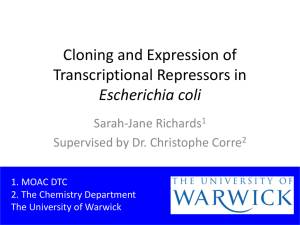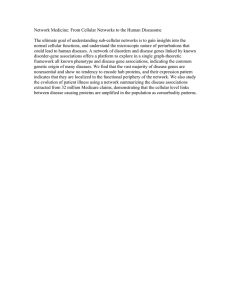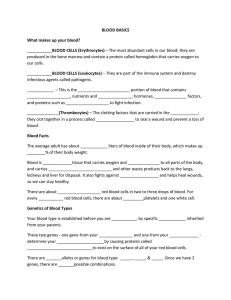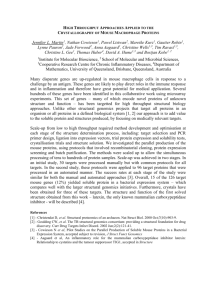Escherichia coli. EXPERIMENTAL RESULTS 1. MOTIVATION Sarah-Jane Richards
advertisement
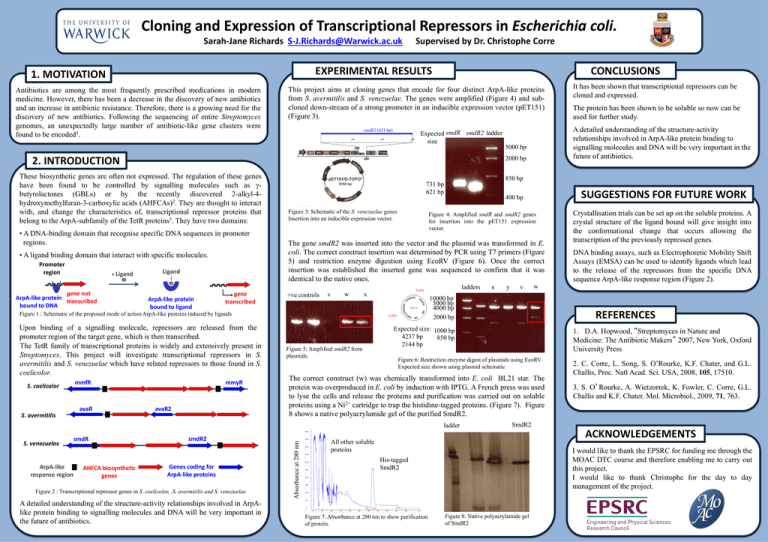
Cloning and Expression of Transcriptional Repressors in Escherichia coli. Sarah-Jane Richards S-J.Richards@Warwick.ac.uk Supervised by Dr. Christophe Corre EXPERIMENTAL RESULTS 1. MOTIVATION Antibiotics are among the most frequently prescribed medications in modern medicine. However, there has been a decrease in the discovery of new antibiotics and an increase in antibiotic resistance. Therefore, there is a growing need for the discovery of new antibiotics. Following the sequencing of entire Streptomyces genomes, an unexpectedly large number of antibiotic-like gene clusters were found to be encoded1. CONCLUSIONS This project aims at cloning genes that encode for four distinct ArpA-like proteins from S. avermitilis and S. venezuelae. The genes were amplified (Figure 4) and subcloned down-stream of a strong promoter in an inducible expression vector (pET151) (Figure 3). smdR2 (621 bp) 200 400 600 Expected smdR smdR2 ladder size These biosynthetic genes are often not expressed. The regulation of these genes have been found to be controlled by signalling molecules such as γbutyrolactones (GBLs) or by the recently discovered 2-alkyl-4hydroxymethylfuran-3-carboxylic acids (AHFCAs)2. They are thought to interact with, and change the characteristics of, transcriptional repressor proteins that belong to the ArpA-subfamily of the TetR proteins3. They have two domains: • A DNA-binding domain that recognise specific DNA sequences in promoter regions. • A ligand binding domain that interact with specific molecules. Promoter region + Ligand gene not ArpA-like protein transcribed bound to DNA Ligand ArpA-like protein bound to ligand gene transcribed Upon binding of a signalling molecule, repressors are released from the promoter region of the target gene, which is then transcribed. The TetR family of transcriptional proteins is widely and extensively present in Streptomyces. This project will investigate transcriptional repressors in S. avermitilis and S. venezuelae which have related repressors to those found in S. coelicolor. S. avermitilis mmfR avaR mmyR avaR2 Figure 4: Amplified smdR and smdR2 genes for insertion into the pET151 expression vector. +ve controls v w x ArpA-like response region AHFCA biosynthetic genes Genes coding for ArpA-like proteins Figure 2 : Transcriptional repressor genes in S. coelicolor, .S. avermitilis and S. venezuelae A detailed understanding of the structure-activity relationships involved in ArpAlike protein binding to signalling molecules and DNA will be very important in the future of antibiotics. y v w Expected size: 1000 bp 4237 bp 850 bp 2144 bp DNA binding assays, such as Electrophoretic Mobility Shift Assays (EMSA) can be used to identify ligands which lead to the release of the repressors from the specific DNA sequence ArpA-like response region (Figure 2). 1. D.A. Hopwood, “Streptomyces in Nature and Medicine: The Antibiotic Makers” 2007, New York, Oxford University Press Figure 6: Restriction enzyme digest of plasmids using EcoRV. Expected size shown using plasmid schematic 2. C. Corre, L. Song, S. O’Rourke, K.F. Chater, and G.L. Challis, Proc. Natl Acad. Sci. USA, 2008, 105, 17510. 3. S. O’Rourke, A. Wietzorrek, K. Fowler, C. Corre, G.L. Challis and K.F. Chater. Mol. Microbiol., 2009, 71, 763. SmdR2 All other soluble proteins ACKNOWLEDGEMENTS I would like to thank the EPSRC for funding me through the MOAC DTC course and therefore enabling me to carry out this project. I would like to thank Christophe for the day to day management of the project. His-tagged SmdR2 Figure 7: Absorbance at 280 nm to show purification of protein. Crystallisation trials can be set up on the soluble proteins. A crystal structure of the ligand bound will give insight into the conformational change that occurs allowing the transcription of the previously repressed genes. REFERENCES The correct construct (w) was chemically transformed into E. coli BL21 star. The protein was overproduced in E. coli by induction with IPTG. A French press was used to lyse the cells and release the proteins and purification was carried out on soluble proteins using a Ni2+ cartridge to trap the histidine-tagged proteins. (Figure 7). Figure 8 shows a native polyacrylamide gel of the purified SmdR2. Absorbance at 280 nm S. venezuelae smdR2 x 10000 bp 5000 bp 4000 bp 2000 bp EcoRV Figure 5: Amplified smdR2 from plasmids. ladders EcoRV ladder smdR SUGGESTIONS FOR FUTURE WORK 400 bp The gene smdR2 was inserted into the vector and the plasmid was transformed in E. coli. The correct construct insertion was determined by PCR using T7 primers (Figure 5) and restriction enzyme digestion using EcoRV (Figure 6). Once the correct insertion was established the inserted gene was sequenced to confirm that it was identical to the native ones. Figure 1 : Schematic of the proposed mode of action ArpA-like proteins induced by ligands S. coelicolor 5000 bp 850 bp 731 bp 621 bp Figure 3: Schematic of the S. venezuelae genes Insertion into an inducible expression vector. The protein has been shown to be soluble so now can be used for further study. A detailed understanding of the structure-activity relationships involved in ArpA-like protein binding to signalling molecules and DNA will be very important in the future of antibiotics. 2000 bp 2. INTRODUCTION It has been shown that transcriptional repressors can be cloned and expressed. Figure 8: Native polyacrylamide gel of SmdR2
